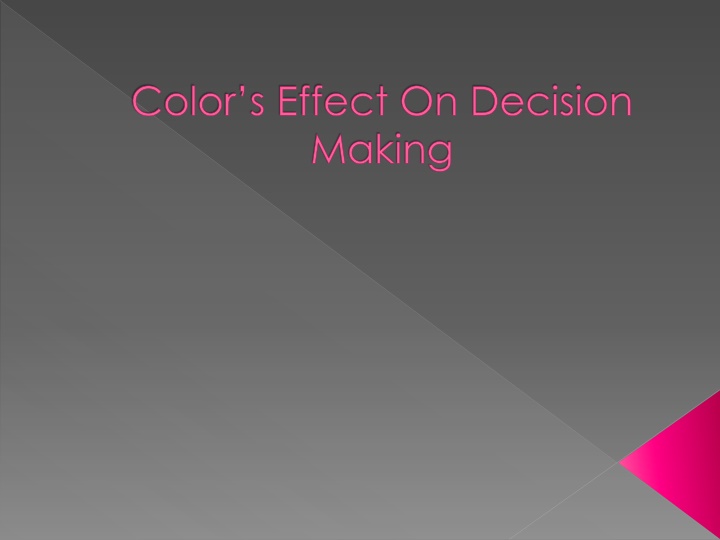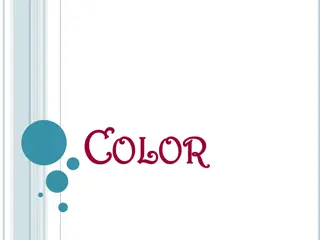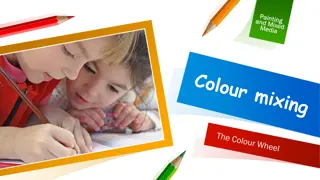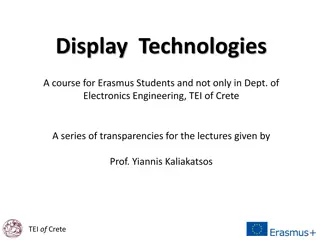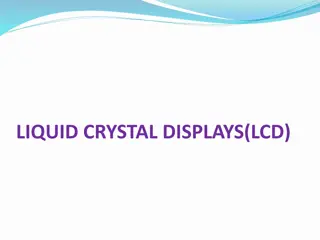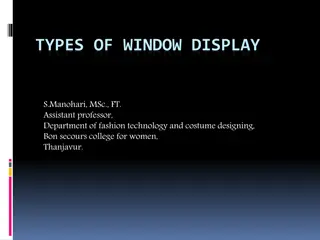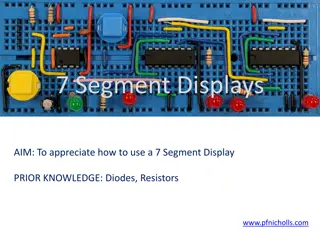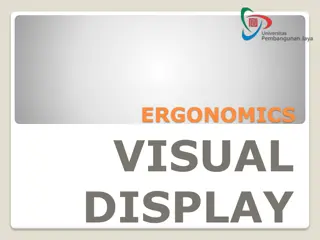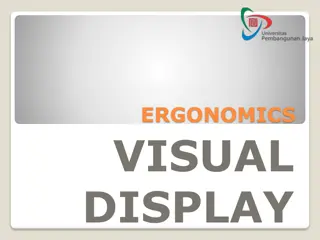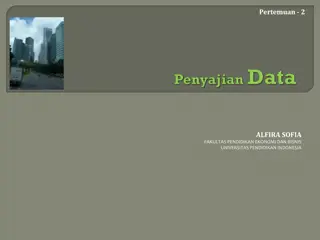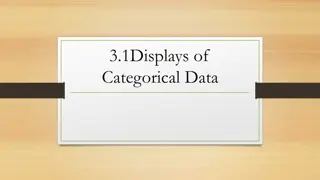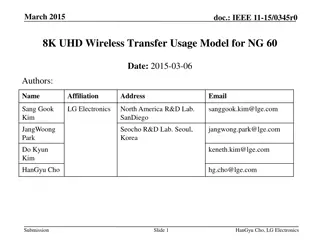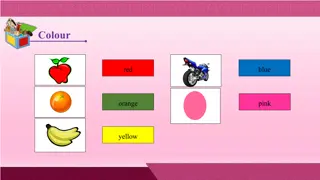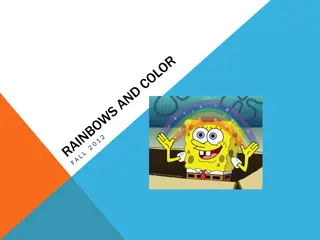The Impact of Colors on Decision Making in Visual Displays
Investigating the influence of color on decision-making, particularly in legal contexts, through the manipulation of photographs with different color schemes. Prior research suggests that color can play a crucial role in how visuals are perceived and remembered, especially in litigation settings. By focusing on color as a key variable, this study aims to contribute to the understanding of the significance of color in visual communication and decision-making processes.
Download Presentation

Please find below an Image/Link to download the presentation.
The content on the website is provided AS IS for your information and personal use only. It may not be sold, licensed, or shared on other websites without obtaining consent from the author.If you encounter any issues during the download, it is possible that the publisher has removed the file from their server.
You are allowed to download the files provided on this website for personal or commercial use, subject to the condition that they are used lawfully. All files are the property of their respective owners.
The content on the website is provided AS IS for your information and personal use only. It may not be sold, licensed, or shared on other websites without obtaining consent from the author.
E N D
Presentation Transcript
Colors Effect On Decision Making
Purpose of the Investigation We wanted to look at the differences between black & white, colored, and digitally enhanced photographs and the Impact they have on decision making. Our reason for choosing this problem is to further investigate previous research that seems to show that color is an important factor when using visuals in litigation.
Background to the Investigation: Big Picture Big Picture: We chose our particular image and manipulation because, from prior research, we learned that photographs are very effective in conveying messages. They are effective because they have an intense visual impact. Also, changing color or color intensity can influence the way individuals perceive the photograph. However, in conducting our research, we had to be cautious not to over manipulate the photo. Golan Fielder Feigenson Dunn Feigenson & Dunn Golan Fielder
Background to the Investigation Golan (2008) Relation to our Research Visual images have started to dominate the court room, giving contending parties even more powerful ways of visualizing their claims in courts. This article gave us the idea to use a photograph in our study instead of another visual display, such as a cartoon, drawing, or sketch. The research explained that photographs have a greater visual impact. Photographs are very different from other visual displays. They record details more accurately and communicate ideas more efficiently than other verbal testimony or visual images.
Background to the Investigation Fiedler (2004) Relation to our Research Relation to our Hypotheses Color can improve a jury s recognition. High contrast colors can cause juries to pay more attention to a particular visual display. Certain combinations of colors can improve a message or convey a false message. Color can also help the jury understand or remember the visual display better. This information lead us to our hypotheses that a color visual display will be more influential than a black & white visual display. This is especially true for high contrast colors This article proved to us that color would be a very effective aspect to manipulate in our visual display for our research.
Background to the Investigation Feigenson & Dunn (2003) Relation to our Research In our research we conducted a simple effects study by manipulating only one aspect of the visual display that we choose. The aspect that we manipulated was color. We chose to only manipulate the color of our image because we did not want our visual display to be excessively manipulative, so it could be used in a litigation case. A simple effect study is a study that only manipulates one aspect or variable in the research. It is wise to only manipulate one aspect of a visual display in litigation cases, because If you manipulate a visual display too much it can lead to many legal problems and a judge can rule out the image.
Hypothesis & Predictions Fiedler (2004) A digitally enhanced photo will influence an individual s decision in a court case more than a black & white photo, and a regularly colored photo in favor of the victim. Color can improve a jury s recognition. High contrast colors can cause juries to pay more attention to a particular visual display. Certain combinations of colors can improve a message or convey a false message. Color can also help the jury understand or remember the visual display better. An individual s decisions will be more influenced by a digitally enhanced photo rather than a black & white or regularly colored photo. A regularly colored photo will influence an individual s decision and have a greater impact on that decision than a black & white photo.
Methods: Designs Black & White Color Digitally Enhanced Color Photo 1 Photo 2 10 10 10 10 10 10
Methods: Materials Three separate photographs of a victim s injuries: Black & white Colored Digitally-enhanced colored Three surveys: Demographic questionnaire Rating of agreement Rating of photograph Influence Libeck V. Mc Donald s case brief.
Picture: Digitally-enhanced colored
Libeck V. McDonalds Case Brief Liebeck spilled her coffee onto her lap. The coffee was estimated to be somewhere between 180 to 190 degrees. These burns extended through to Liebeck s subcutaneous fat, muscle, and bone. Libeck was hospitalized for eight days and underwent skin grafting and later underwent debridement treatments. Libeck was permanently disfigured and disabled for two years following this incident. McDonald srefused to compensate with Liebeck s request of meeting her medical payments. At trial McDonald s also argued that Liebeck contributed to her own injury by placing the coffee cup in between her legs and not removing her clothing directly after she had spilt her coffee. McDonald s admitted that the number of hot coffee burns suffered by McDonald s costumers are statistically insignificant in comparison to the one billion cups of coffee sold by McDonald s each year. After seven days of deliberation and reviewing evidence, the jury found McDonald s liable on the claims of product defect Finally the jury awarded Ms. Liebeck 2.7 million dollars in punitive damages on its findings of willful, reckless, malicious, wanted conduct.
Methods: Materials Survey Questions Survey 1 Question One: Rate the degree to which you agree or disagree with the final outcome of 2.7 million dollars, given to the victim for compensation of her injuries. Question Two: Rate the degree to which the photograph you were provided had an effect on your decision. Survey 2 Question One: Rate the degree to which the second photograph you were provided had an effected your decision.
Methods: Materials Scale: Rating of agreement for survey one question one. Agree Disagree -5 -4 -3 -2 -1 0 1 2 3 4 5 Scale: Rating of photograph influence for survey one question two and survey two question one. Not Effective Extremely Effective -5 -4 -3 -2 -1 0 1 2 3 4 5
Methods: Materials Packet for participant s: Packet1: Digitally enhanced color/Color Packet2: Digitally enhanced color/Black & White Packet3: Color/Black & White Packet4: Color/Digitally enhanced color Packet5: Black & White/Color Packet6: Black & White/ Digitally enhanced color All packet s included: All three surveys The case brief Two randomized photographs as listed above
Methods: Materials iPhoto Used to manipulate the colored photograph creating the digitally enhanced photograph. When manipulating the visual display, we changed: Exposure: from 0 to .88. Contrast: from 0 to 29. Highlights: from 0 to 50. Shadows: from 0 to 50. Saturation: from 50 to 75. Sharpness: 0 to .80.
Methods: Subjects 45 Females 15 Males Ages 19-31 Mean Age: 21.35 All students were randomly sampled from California State University, Chico.
Methods: Procedure for researchers 2. Participants were instructed to: 1. Not read ahead. 2. Fill out two surveys that would correspond with two photos. 1. Presented the participants with a packet at random.
Methods: Procedures for participant's 2. Participant s read the Libeck V. McDonald s case brief. 1. Participant s filled out demographic survey. 3. Participant s looked at the first photograph in their particular packet, then answered survey one based on the photograph. 4. Participant s looked at second photograph in their particular packet, then answered survey two.
Results: Data Reduction Data corresponding to the information we received from participant s was entered into SPSS. This determined the differences between each group depending on the photograph they received and in what order they received it.
Results: Statistics Treatment: F-test Rate of Agreement There is a statistically significant difference in award strength somewhere between the color, black & white, and digitally enhanced photographs. F=(2,57)=4.15, p=.02
Results: Statistics Post Hoc, Award Strength In order to determine between which pair the difference lies, a Tukey test was used. The results reveled the following: Black & White/ Color: Mdiff= -2.45, p=.017 Significant Difference Black & White/Digitally Enhanced: Mdiff= -1.5, p=.181 Not Significant Color/ Digitally Enhanced: Mdiff= .900, p=.55 Not Significant BW> C BW= DE C = DE
Results: Rates for Award Strength Award Strength 3.5 3 2.5 2 1.5 Award Strength 1 0.5 0 Black & White Color Digitally Enhanced
Results: Statistics Post Hoc, Photograph Influence In order to determine between which pair the difference lies, a Tukey test was used. The results reveled the following: Black & White/ Color: Mdiff= -1.9, p=.076 Not Significant Black & White/ Digitally Enhanced: Mdiff= -.80, p=.620 Not Significant Color/ Digitally Enhanced: Mdiff= 1.10, p=.408 Not Significant BW=C BW= DE C = DE
Results: Photograph Influence Photo Influence 4 3.5 3 2.5 2 Photo Influence 1.5 1 0.5 0 Black & White Color Digitally Enhanced
Discussion Hypotheses Finding Interpretation Not supported: No significant difference between digitally enhanced and black & white. The colored photograph impacted an individual s decision more than the digitally enhance photograph, in favor of the victim. Hy1: A digitally enhanced photograph will influence an individual s decision in a court case more than a black & white photograph, and a regularly colored photograph, in favor of the victim. Not supported: The colored photograph influenced an individual s decision more than the digitally enhanced photograph. There was no significant difference between black & white and digitally enhanced. Hy2:An individual s decisions will be more Influenced by a digitally enhanced photograph than black & white or regularly colored photograph. Hy3:A regularly colored photograph will influence an individual s decision and have a greater impact on that decision than a black & white photograph. Supported: The colored photograph was significantly more influential on an individual s decision. The colored photograph had a greater impact on that decision than the black & white photograph.
Interpretation: Hypothesis 1 and 2 An important factor related to experiential engagement with stories appears to be the level of realism we see reflected in them. It seems plausible that stories we consider authentic and true to life are most engaging. (Busselle & Bilandzic, 2008) Since the digitally enhanced photo was not realistic or true to life participants may have not been able to relate to the photograph. Therefore the original colored photograph had more of an influence on the participants because the photo was relatable to what we would experience in real life. The black and white was not significantly different from the digitally enhanced photo because neither one was very realistic.
Interpretation: Hypothesis 3 Color can improve a jury s recognition. Certain combinations of colors can improve a message or convey a false message. Color can also help the jury understand or remember the visual display better. (Fiedler 2004) Color is important in directing attention toward visual displays. Color is also important in understanding visuals displays.This may have caused the colored photograph to be the most influential and to have the greatest impact on the participants.
General Conclusions: Theory Colored visual displays, particularly photographs, are more influential and have a greater impact than black & white visual displays.
General Conclusions: Methods The number of participants was relatively low. Thus, had we employed a larger N , it is likely one of our findings would have reached significance. The amount of time the picture was shown could have been controlled, being either longer or shorter. We could have used multiple different kinds of color enhancements on the photograph.
General Conclusions Methods The photographs that we used were very grotesque. We could have used more neutral photographs. If the photographs were more neutral we may have had different results. The case that we used was very controversial . If we would have used a less controversial case we may have had different results. If we did not use a litigation case at all and instead simply displayed photographs, our results may have been different.
General Conclusions: Results Award Strength: Color may have had a higher award strength because it was the most realistic of all the photographs. Individuals may have been able to relate to the victim more when looking at the real life photograph. Therefore, the participants felt the victim deserved a higher lever of compensation. Photo Influence: Our results were very close to significant between the black & white and color groups, therefore if we had a larger N our results may have been significant.
General Conclusions: Limitations Not a good female to male ratio. More participants may have made one of the results statistically significant. Participants were all college students.
General Conclusions: Generalizations We could not generalize our research to visual displays outside of this specific context. Our research used very grotesque photographs and a very controversial case, which may have changed our results. Thus, future research using a more neutral photograph could not be generalized to the research we conducted.
General Conclusion: Suggestions for future research Try different kinds of visual enhancements: Changing the size of the picture Manipulating the color so only one important color stands out such as red. Use more of a neutral photo. Use a less controversial case. Utilize a wider variety and larger number of participants.
References Busselle, R., & Bilandzic, H. (2008). Fictionality and Perceived Realism in Experiencing Stories: A Model of Narrative Comprehension and Engagement. International Communication Association. 255-280. Feigenson, N., & Dunn, M. (2004). New Visual Technologies in Court: Directions for Research. Journal of Law and Human Behavior. 27(1), 109-126. Fiedler, B. (2004). Are Your Eyes Deceiving You?: The Evidentiary Crisis Regarding the Admissibility of Computer Generated Evidence. New York Law School Law Review. 48, 295-321. Golan, T. (2008). Visual Images in the Courtroom: a Historical Perspective. Parallax. 14(4), 77-89.
